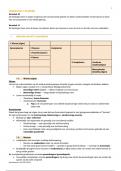Summary
Summary Psychobiology, Vakcode: WBBY063-05, ISBN: 9781292158105
- Course
- Institution
- Book
This summary includes all the information that you need for the course Psychobiology. The summary is 151 pages long, because it contains a lot of information, but also a lot of describing pictures which means that you can go fast through it. By reading and understanding this summary you don't even ...
[Show more]














